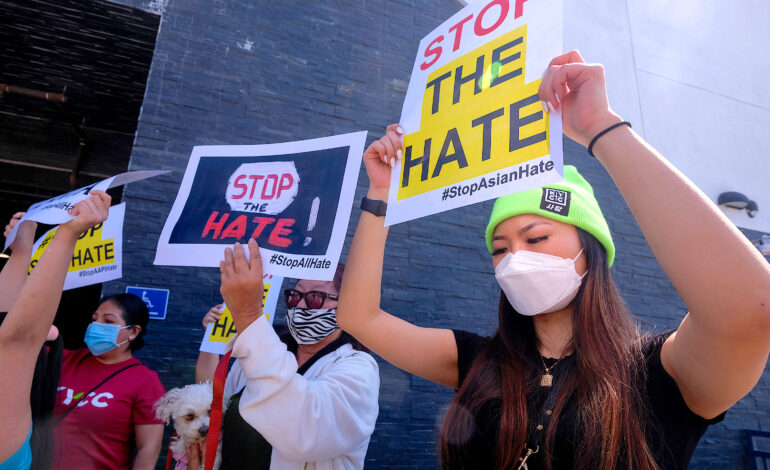After the release of the FBI’s annual hate crime statistics, a civil rights group is asking the Biden administration to make federal assistance to local law enforcement agencies contingent on their reporting and compiling of hate crime data.
The FBI’s latest statistics on hate crimes show the biggest spike since 2008. The report summarizes data submitted by 5,136 law enforcement agencies, on offenses, victims, offenders and locations of hate crimes.
The FBI says those agencies submitted incident reports involving 7,759 criminal incidents and 10,532 related offenses in 2020 motivated by bias toward race, ethnicity, ancestry, religion, sexual orientation, disability, gender and gender identity, about 450 more than were reported in 2019.
According to the FBI, there were 7,554 “single-bias” (motivated by bias against one characteristic) incidents involving 10,528 victims. But the increase comes as even fewer law enforcement agencies reported hate crimes in their jurisdictions to the FBI than in prior years.
The Council on American-Islamic Relations (CAIR), a nationwide Muslim civil rights and advocacy organization, says the administration should do more to make sure these crimes are reported fully and accurately by local agencies.
Because law enforcement agencies are not required to submit their data to the FBI for its annual report, the recently released statistics are likely an undercount. More than 3,000 of the nation’s 18,000 law enforcement agencies did not submit their 2020 statistics to the FBI, the organization said in a release.
“The disturbing rise in hate crime incidents nationwide requires the attention and effort of all law enforcement agencies,” said CAIR Government Affairs Director Robert McCaw. “The fact that the actual number of hate crime incidents is likely much higher than the statistics provided in Monday’s FBI report highlights the pressing need for communication and coordination between agencies.
McCaw said CAIR is calling on Congress and the Biden administration to work together to require the federal government to condition any aid, grants, training or other assistance to local law enforcement agencies on their agreement to submit regular and complete data regarding hate crime incidents targeting minority communities.
Of the 6,431 “known offenders” in the report, 55.2 percent were White and 20.2 percent were Black or African American. Attacks targeting Black people rose to 2,755 from 1,930 last year and attacks on Asian Americans rose to 271 from 164 as misguided and racist sentiment against the population intensified in the wake of the COVID-19 pandemic. The novel virus was first identified in Wuhan, China, in December of 2019.
Anti-Muslim bias dropped slightly from 180 incidents reported to the FBI in 2019 to 104 in 2020. There were 69 anti-Arab incidents reported, a drop from 93 in 2019.
The FBI also says the data may not be comparable to previous years because of differing levels of participation by local agencies in reporting hate crimes over time. It also discourages ranking locations or making comparisons as crime is a sociological phenomenon influenced by a variety of factors.
2020 statistics
The FBI’s website summarizes the 2020 hate crime statistics, as part of its Uniform Crime Reporting (UCR) program, into several categories:
Victims of hate crime incidents
There were 7,554 single-bias incidents involving 10,528 victims. A percent distribution of victims by bias type shows that 61.9 percent of victims were targeted because of the offenders’ race, ethnicity or ancestry bias; 20.5 percent were victimized because of the offenders’ sexual orientation bias; 13.4 percent were targeted because of the offenders’ religious bias; 2.5 percent were targeted because of the offenders’ gender identity bias; 1 percent were victimized because of the offenders’ disability bias and 0.7 percent were victimized because of the offenders’ gender bias.
There were 205 multiple-bias hate crime incidents that involved 333 victims.
Offenses by crime category
Of the 7,426 hate crime offenses classified as crimes against persons in 2020, 53.4 percent were for intimidation, 27.6 percent were for simple assault and 18.1 percent were for aggravated assault. Twenty-two murders and 19 rapes were reported as hate crimes. The remaining 27 hate crime offenses were reported in the category of “other.”
Of the 2,913 hate crime offenses classified as crimes against property, most (76.4 percent) were acts of destruction, damage or vandalism. Robbery, burglary, larceny-theft, motor vehicle theft, arson and other offenses accounted for the remaining 23.6 percent of crimes against property.
One hundred ninety-three (193) additional offenses were classified as crimes against society. This crime category represents society’s prohibition against engaging in certain types of activity such as gambling, prostitution and drug violations. These are typically victimless crimes in which property is not the object.
Statistics on offenders, locations of hate crimes and more can be found on the FBI’s website.







Leave a Reply